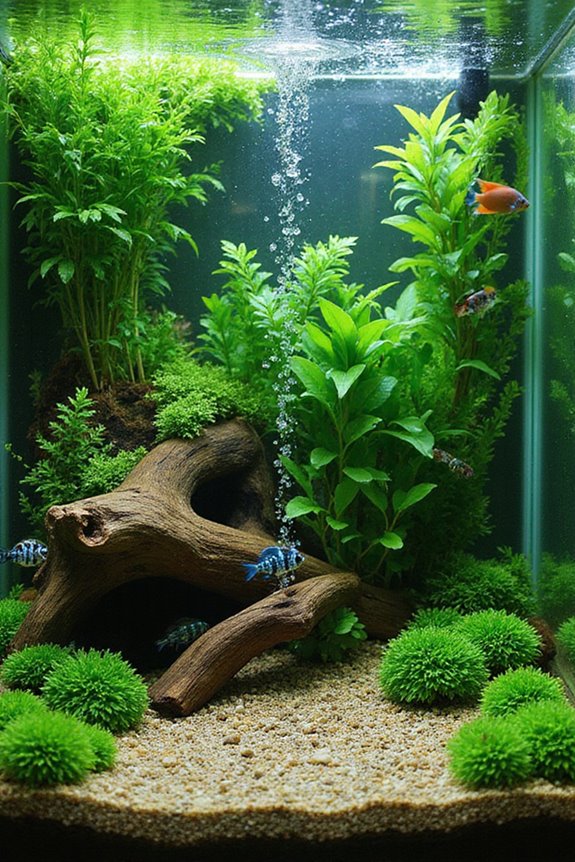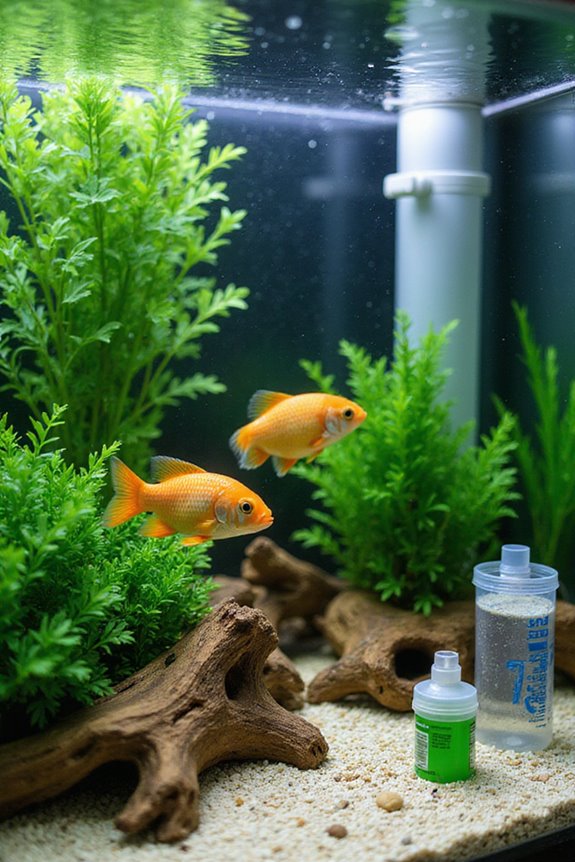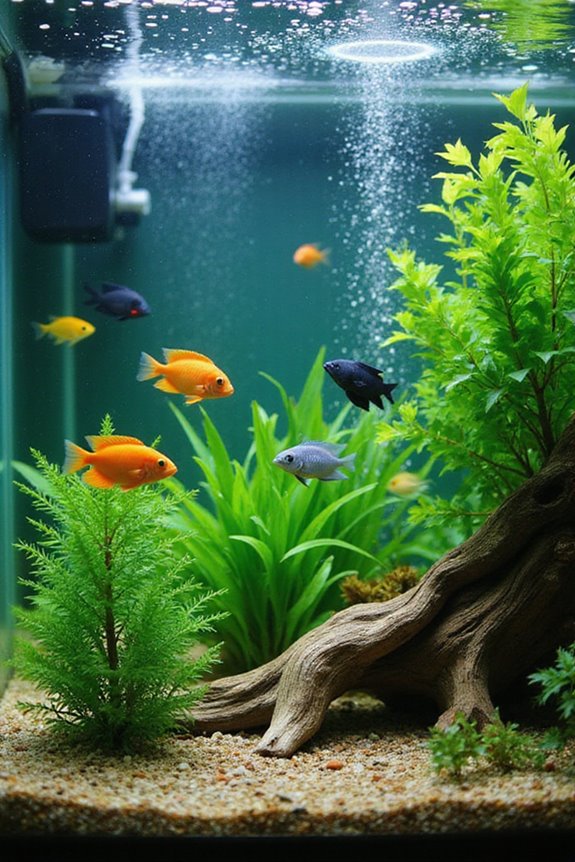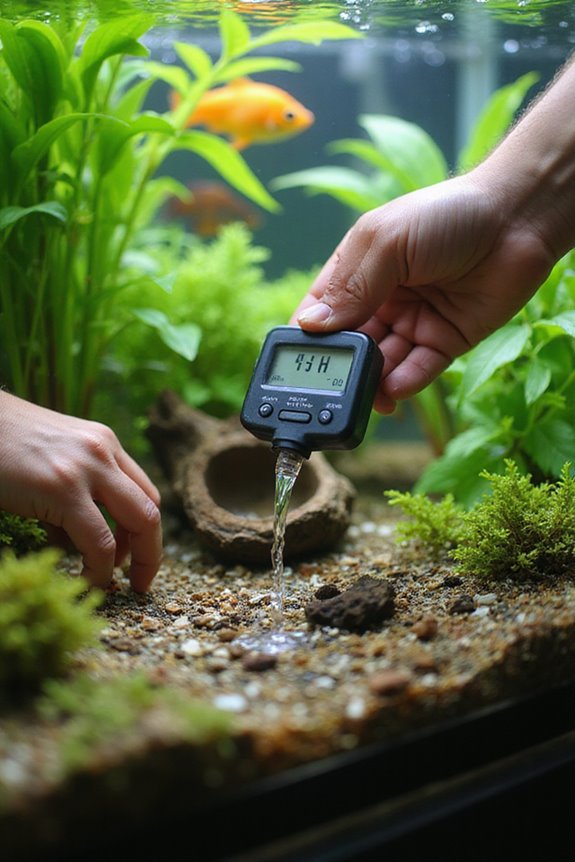To lower nitrates in your fish tank, start by performing weekly water changes of 10-30%. Next, add fast-growing live plants like anacharis or hornwort to absorb excess nitrates. Utilize live rock for its beneficial bacteria, and create deep sand beds to promote denitrification. Enhance filtration with high-performance canister filters and consider using products like API NITRA-ZORB for added nitrate removal. Monitor your water parameters regularly for ideal results, and you’ll discover more effective strategies ahead.
Key Takeaways
- Perform weekly water changes, replacing 10-30% of tank water to control nitrate levels and improve water quality.
- Add fast-growing live plants to absorb nitrates and enhance tank health.
- Utilize live rock and deep sand beds to create anaerobic zones for denitrifying bacteria.
- Upgrade to high-performance filters and incorporate nitrate-lowering media for effective filtration.
- Implement chemical and natural nitrate removers, such as nitrate sponges and advanced biological media.
Perform Regular Water Changes
Performing regular water changes is essential for maintaining a healthy aquarium environment. I recommend a water change frequency of once a week, replacing about 10-30% of the tank’s water. This routine helps control nitrate accumulation, improving water quality for your fish. When nitrates spike, consider a one-time large water change of 75-90% to quickly drop levels. Always match the new water’s temperature and parameters to avoid stressing your fish. Use a reliable siphon or gravel vacuum to remove debris and waste effectively. Make sure to treat the new water with a dechlorinator to protect your fish. Monitoring nitrate levels regularly will guide your water change schedule, ensuring a balanced and thriving aquatic habitat.
Add and Maintain Live Plants
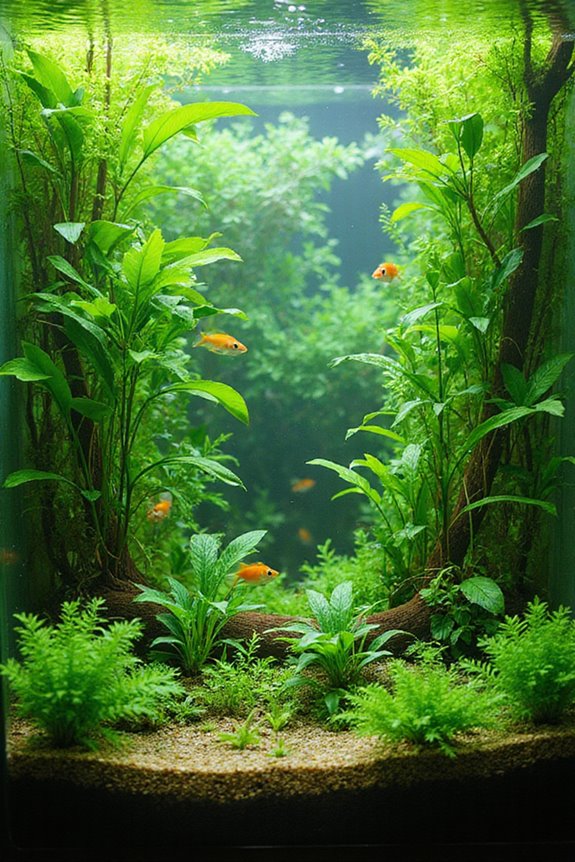
Adding and maintaining live plants in your aquarium is a practical way to lower nitrate levels while enhancing your tank’s overall health. Fast-growing plant species, like anacharis, hornwort, and water sprite, are ideal due to their high nutrient demand and growth rates. Guarantee proper lighting conditions to promote photosynthesis and consider using substrate fertilizers for better nutrient balance. Regular pruning techniques are essential to prevent decay that can release nitrates back into the water. Aim for a dense planting to maximize nitrate absorption and support aquatic ecosystems. Additionally, emergent plants can help with algae control, providing shade and habitat for your fish. Monitoring plant health and replacing dying plants keeps your nitrate reduction efforts effective.
Utilize Live Rock and Deep Sand Beds
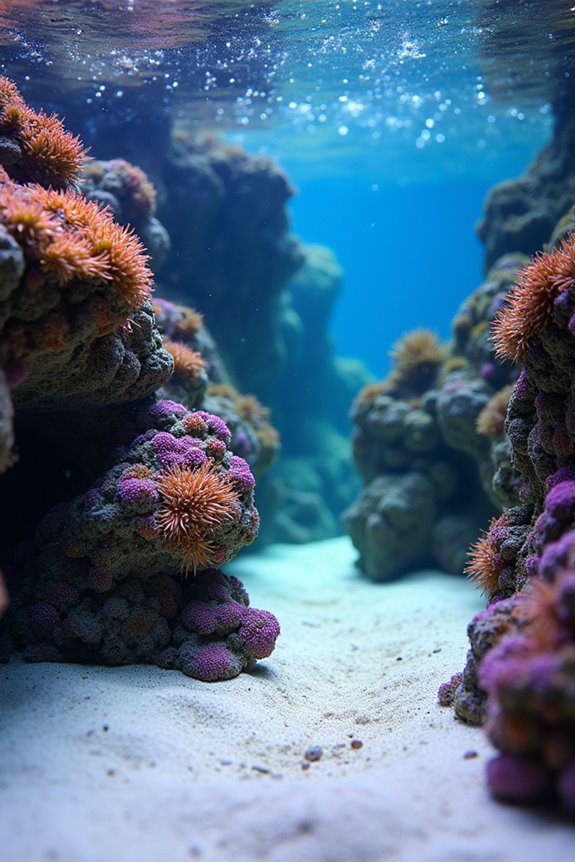
Utilizing live rock and deep sand beds in your aquarium setup can significantly assist in reducing nitrate levels. Live rock acts as a natural filter, hosting aerobic bacteria that break down ammonia and nitrite, while its internal crevices provide low-oxygen areas for denitrifying bacteria to convert nitrate into nitrogen gas. To maximize effectiveness, arrange your live rock to promote best water flow. Deep sand beds, at least four inches thick, create perfect anaerobic zones for further nitrate reduction. Regular maintenance is essential; remove detritus buildup on live rock and monitor deep sand beds for toxic gas pockets. Together, live rock and deep sand beds enhance biological filtration, providing a balanced nitrogen cycle without chemical additives.
Enhance Filters and Equipment

Enhancing filters and equipment in your aquarium is essential for managing nitrate levels effectively. Upgrading to high-performance canister filters is a great start. These filters often have removable prefilter sections that improve mechanical removal of organic waste, which helps reduce nitrate buildup. I recommend placing ion exchange resins, like API NITRA-ZORB, in the filter’s water flow path to target nitrates directly. This resin can be reused after recharging, making it both cost-effective and sustainable. Regularly maintaining your canister filter and replacing media will sustain its nitrate-lowering capabilities. By optimizing your filtration system, you create a healthier environment for your fish while keeping nitrates in check. Consider these enhancements to guarantee your aquarium thrives.
Implement Chemical and Natural Nitrate Removers
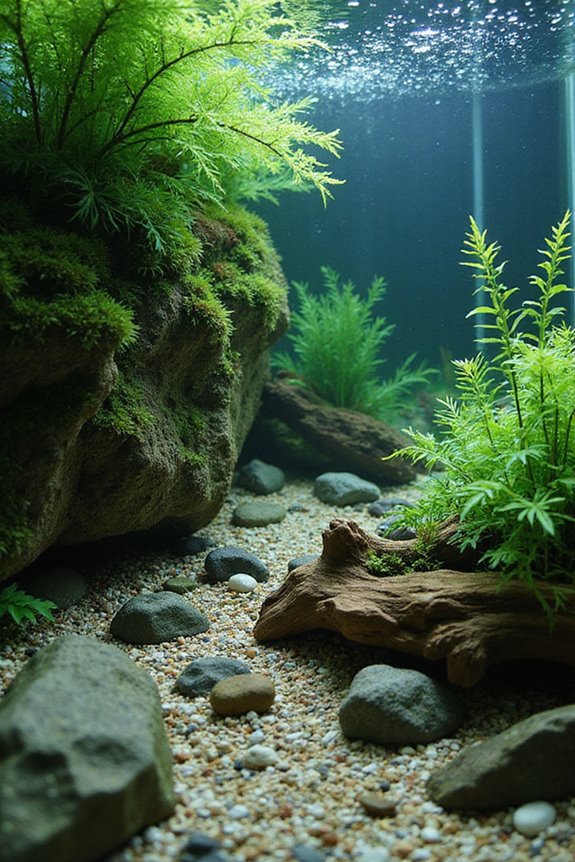
When it comes to managing nitrates in your aquarium, implementing chemical and natural nitrate removers can make a significant difference. I recommend using chemical additives like Tetra Easy Balance, which effectively lowers nitrate levels while balancing other water parameters. For a more biological approach, consider nitrate sponges that promote anaerobic bacteria, helping to denitrify over time. You can find these sponges integrated into various filter systems, guaranteeing compatibility with your setup. Additionally, using nitrate sponges that chemically absorb nitrates can provide quicker results. For sustained management, look into advanced biological media such as Dr. Tim’s NP Active Pearls, which can offer a long-term solution for both freshwater and saltwater tanks. Regularly monitor nitrate levels to ascertain effectiveness.
Adopt Preventative Practices
Adopting preventative practices is essential for maintaining low nitrate levels in your fish tank, as these measures can greatly reduce nitrate production before it becomes a problem. First, consider your fish population; keeping fewer fish helps lower waste, directly reducing nitrates. Next, establish a consistent feeding schedule by providing smaller amounts of food more frequently, which minimizes leftover food that contributes to nitrate buildup. Adding live plants is another effective strategy, as they absorb nitrates while growing. Fast-growing species like water sprite can thrive in your tank, acting as a natural nitrate sink. Regular partial water changes also remain vital—removing 30-50% of water helps physically eliminate nitrates, keeping your tank healthy and balanced.
Monitor Water Parameters Regularly
Monitoring water parameters regularly is an essential part of maintaining a healthy fish tank. I recommend using nitrate testing kits, like strip tests for quick checks or drop tests for accuracy. These kits help me gauge nitrate levels, ensuring they remain below the safe range of 20-40 ppm. To gain a complete picture, I incorporate other parameters like pH, ammonia, and hardness into my testing routine. I use digital monitors for real-time data, which helps maintain water stability. It’s vital to note any fluctuations, especially after feeding or introducing new fish. By keeping detailed logs of my test results, I can track trends and make informed decisions, promoting a balanced environment for my aquatic life.
Frequently Asked Questions
How Often Should I Test My Water Parameters?
I’ve found that testing water parameters monthly is key for stable tanks. However, I test more frequently if nitrate levels rise or when adding fish. Consistent monitoring keeps my aquarium healthy and thriving.
Can I Use Tap Water With High Nitrates?
I wouldn’t recommend using tap water with high nitrate levels. It can harm fish health. I always test my water first to guarantee it’s safe, opting for alternatives if nitrates exceed safe limits.
What Fish Species Tolerate High Nitrate Levels?
I know it sounds risky, but many nitrate-resistant species, like guppies and mollies, are surprisingly compatible in community tanks. They thrive even in higher nitrates, making them great choices for a less stringent setup.
How Do I Identify Nitrate Sources in My Tank?
To identify nitrate sources in my tank, I check for algae growth, uneaten food, and decaying plants. I also monitor fish load, as it affects nitrate absorption, ultimately helping me manage levels effectively.
What Are the Symptoms of Nitrate Toxicity in Fish?
When I watch my fish, their vibrant energy turns to shadows; nitrate effects can manifest as lethargy, loss of appetite, and strange behavior. It’s heartbreaking to see them struggle—understanding these signs is essential for their survival.

